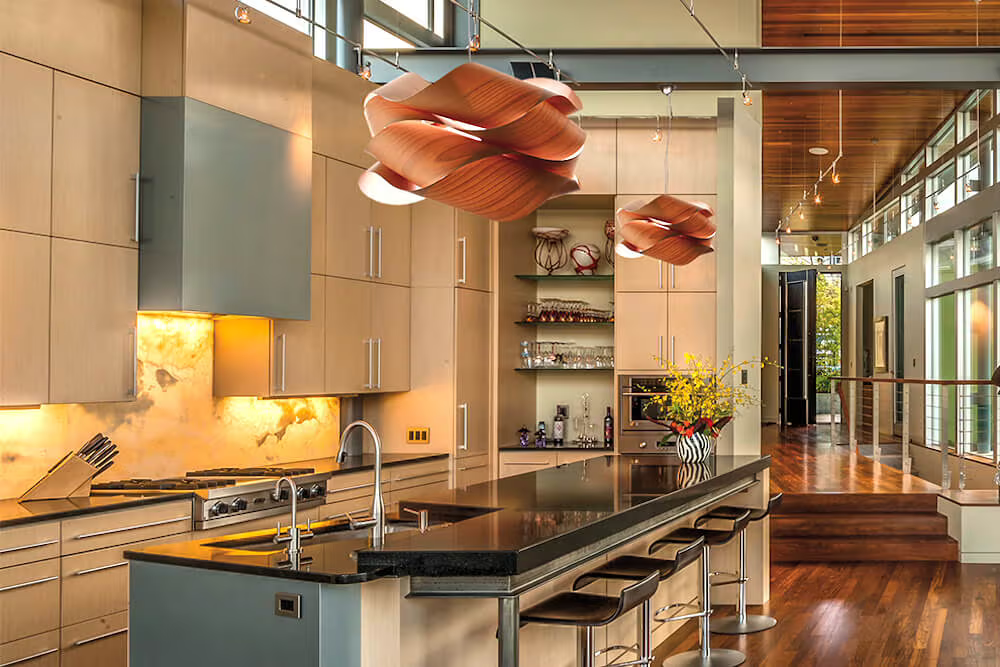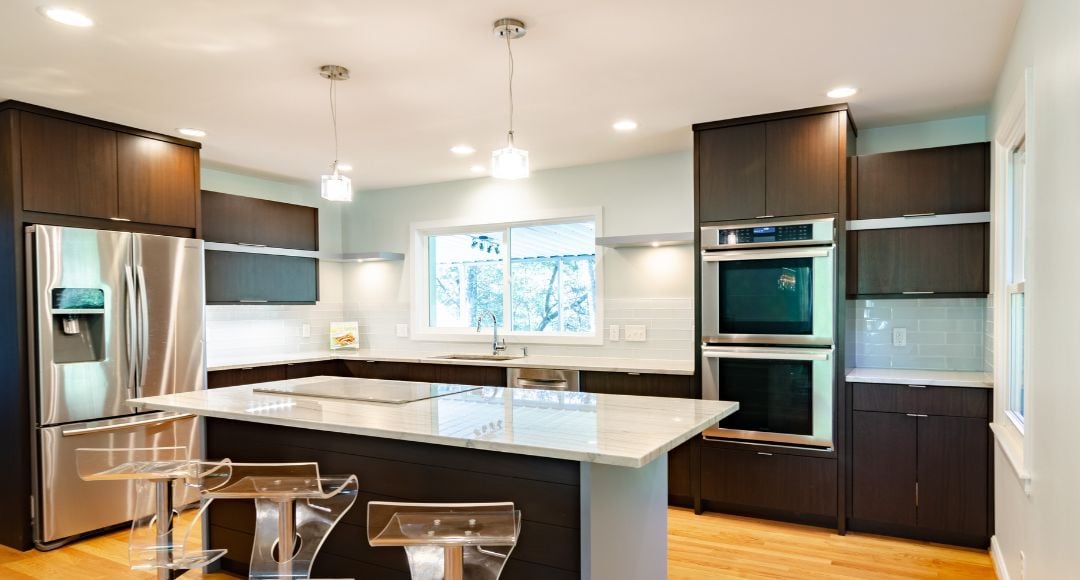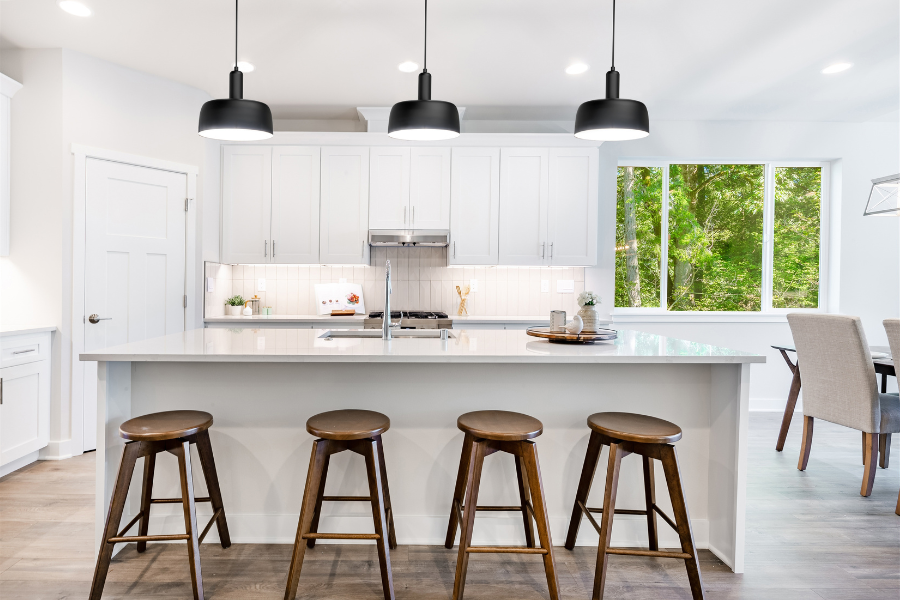When it comes to home decor, lighting is often the unsung hero.
We tend to focus on furniture, color palettes, and wall art, but lighting can make or break a room’s ambiance.
Enter the art of layering lighting—a technique that transforms spaces from mundane to magical.
Let’s delve into how you can master this art to create a warm, welcoming, and well-lit home.
The Fundamentals of Layered Lighting

(Photo from 2Modern)
Layered lighting involves using multiple light sources to create a balanced, versatile, and visually appealing environment. There are three primary layers to consider: ambient, task, and accent lighting. Each serves a unique purpose and, when combined, they create a harmonious lighting scheme that enhances both function and style.
Ambient Lighting: The Foundation
Think of ambient lighting as the foundation of your lighting design. It's the primary source of light that ensures a room is well-lit and functional. This type of lighting includes overhead fixtures like chandeliers, recessed lights, and flush mounts. It sets the overall tone and provides a comfortable level of brightness without causing glare.
To create effective ambient lighting, consider the size and purpose of the room. Large living spaces may benefit from multiple recessed lights or a statement chandelier, while smaller rooms might only need a flush mount ceiling light. Dimmer switches are a great addition, allowing you to adjust the brightness to suit different times of day and activities.
Task Lighting: Focused and Functional
Task lighting is all about practicality. It provides focused light for specific activities such as reading, cooking, or working. Examples include desk lamps, under-cabinet kitchen lights, and bathroom vanity lights. Task lighting reduces eye strain and improves efficiency by illuminating the areas where precision is needed.
When planning task lighting, think about where you perform your daily activities. In the kitchen, under-cabinet lighting brightens countertops, making meal prep easier and safer. In the home office, a well-placed desk lamp ensures you can work comfortably without shadows. For bedrooms, bedside reading lamps or wall-mounted sconces are perfect for nighttime reading.
Accent Lighting: The Showstopper
Accent lighting adds drama and highlights the room’s architectural features or decor. It's used to draw attention to artwork, plants, textured walls, or any focal points you want to showcase. Spotlights, track lighting, and picture lights are common choices for accent lighting.
To use accent lighting effectively, consider what you want to highlight in each room. In the living room, a picture light can draw attention to a beautiful piece of art, while in the hallway, wall sconces can accentuate architectural details. Accent lighting should be brighter than ambient lighting but not as bright as task lighting, creating a contrast that makes your highlights pop.
The Perfect Blend: Creating Harmony

(Photo from Simple Lighting)
The magic of layered lighting lies in the balance. Each layer should complement the others, creating a cohesive look. Here are some tips to achieve a perfect blend:
-
Plan Ahead: Consider the lighting needs of each room during the design phase. Think about the activities that will take place and the mood you want to create.
-
Use Dimmers: Dimmers are your best friend. They allow you to control the intensity of your lighting layers, making it easy to transition from bright and lively to soft and intimate.
-
Choose the Right Bulbs: The type of bulb you use can greatly affect the quality of light. LED bulbs are energy-efficient and come in a variety of color temperatures, from warm to cool. Match the bulb type to the function of the light—warmer tones for ambient lighting and cooler tones for task lighting.
-
Mix and Match Fixtures: Don’t be afraid to mix different types of fixtures. A chandelier can coexist with recessed lights and table lamps, adding depth and interest to the room.
-
Consider Light Placement: The placement of your lights is crucial. Overhead lights should be centered, while task lights should be positioned to avoid casting shadows. Accent lights should highlight your room’s best features.
Room-by-Room Lighting Tips

(Photo from Multi Lighting)
Each room in your home serves a different purpose and thus requires a unique lighting approach. Here’s a quick guide to get you started:
Living Room
- Ambient: Use a combination of recessed lights and a central fixture like a chandelier or ceiling fan with lights.
- Task: Include floor lamps next to seating areas for reading.
- Accent: Highlight artwork, bookshelves, or architectural details with spotlights or picture lights.
Kitchen
- Ambient: Overhead recessed lights or a central pendant light.
- Task: Under-cabinet lighting for countertops, pendant lights over the island.
- Accent: Inside cabinet lighting to showcase glassware or decorative pieces.
Bedroom
- Ambient: A central ceiling light or chandelier.
- Task: Bedside table lamps or wall-mounted sconces for reading.
- Accent: Cove lighting to add a soft glow and enhance relaxation.
Bathroom
- Ambient: Overhead recessed lights or a central fixture.
- Task: Vanity lights around the mirror for grooming.
- Accent: LED strips under cabinets or around a bathtub for a spa-like feel.
Home Office
- Ambient: Ceiling lights or floor lamps.
- Task: A focused desk lamp.
- Accent: Shelf lighting to highlight books or decor.
Conclusion
Layering lighting in your home is an art that combines creativity and practicality. By thoughtfully incorporating ambient, task, and accent lighting, you can transform any space into a well-lit, inviting, and functional environment. Whether you’re reading a book, cooking a meal, or hosting a dinner party, the right lighting can set the perfect mood and make your home shine. So go ahead, experiment with different layers, and watch your home come to life in a whole new light.
Thank you guys so much for taking the time to read this blog post - we here at Connect truly appreciate it! For all the latest home related blog content, keep your tabs posted on our socials: we get new posts up every Tuesday, Thursday, and Sunday!
Check out these websites as well - they provided us with the inspiration to create this blog post!
Houzz: https://www.houzz.com/magazine/a-beginners-guide-to-lighting-in-layers-stsetivw-vs~60963736
Illuminated Integration: https://illuminated-integration.com/blog/light-layering/
Lumens: https://www.lumens.com/the-edit/the-guides/the-fundamentals-of-light-layering/
Pooky: https://www.pooky.com/blogs/inspiration/home-lighting-design-a-guide-to-layering-light